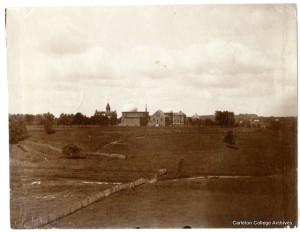Today, the Lyman Lakes are an integral part of Carleton’s campus.

But they weren’t always there.
About a hundred years ago, it looked like this, instead:
In order to learn about the dredging and creation of Lyman Lakes before starting my Google Sketch-Up project, I have been dredging up historical photos of the Lyman Lakes from the early 1900s until the 1960s. This has been a multi-step process: finding photos, gathering metadata about them, and then recording that metadata in a spreadsheet.
Finding Photos
This step wasn’t terribly difficult. After searching through some digital books with very limited success, I searched Carleton’s digital database – with success! There were some oldies, but goodies (like the one above) as well as some lovely colorful ones from multiple angles. I chose the handful of photos that showed enough of the lakes and their surroundings to actually be useful, once I try to model them.
This process is something I’m quite used to. I’ve searched lots of digital archives in order to do research for projects in high school, and felt pretty comfortable doing the same thing here.
Gathering Metadata
Gathering the metadata from the digital archives was actually quite difficult. Most of the information readily given about the photo was pretty limited, with only the title, general date, and maybe a description. In general, however, they nearly always lacked information about the creator or contributors:
Gathering this kind of data was pretty similar to gathering data to create MLA or APA citations pages, although the specifics and terminology of Dublin Core has taken some getting used to.
Recording Metadata
The spreadsheet system was very easy and clear to use. The only complicated part was inputting data at the same time as another person. At least once, my data was inadvertently erased as someone else attempted to use the same line to input their data.
I have never used a spreadsheet system to record citation/identification information for citation pages, and in some ways using a spreadsheet was a bit more work, but the result is a clean and easy to understand catalog of photos.


Really well done post! Your formatting with this stuff and this stuff (not sure if all of that will work in a comment, fingers crossed; ah, shoot, looks like I don’t know how to change font color in a comment) made it so much easier to read and follow. Nice comparison to gathering data for citations–I never realized that that “counted” as metadata.